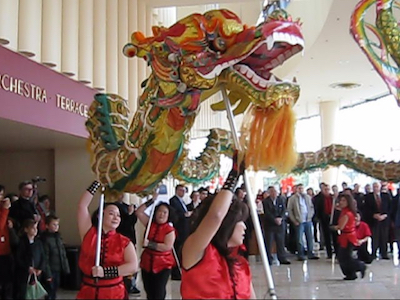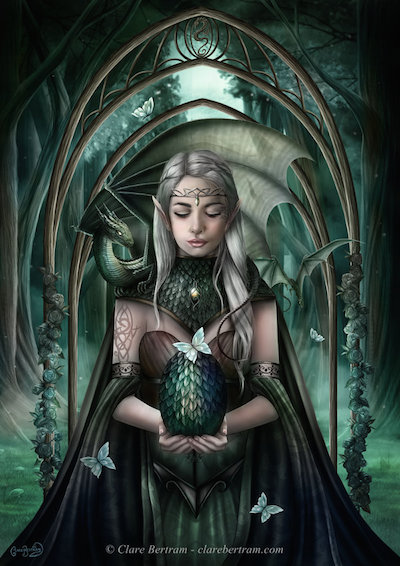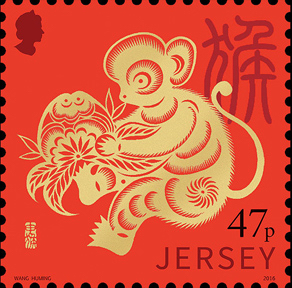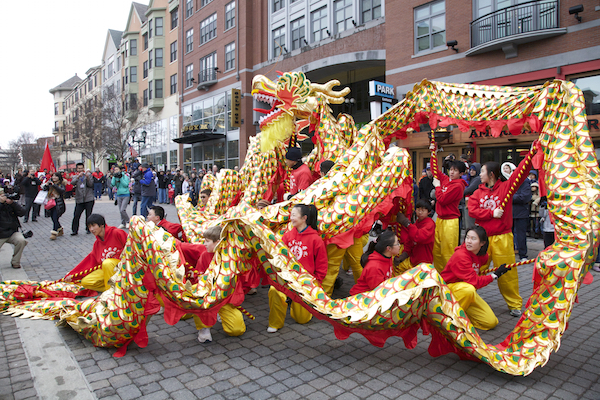Today is Imbolc, the first day of Spring, one of the four Celtic seasonal holidays that fall on the calendar mid-points between the equinoxes and solstices.
Like most Pagans, I honor Brigid, the Goddess associated with: the water of holy wells, the hearth fire, the fertile earth of Spring and mental air energy needed to create poetry. She also offers needed protection.
But what does Brigid have to do with the Chinese Dragon?
To answer this question, first keep in mind this Asian mythological character is benevolent, protective, and inspiring— quite the opposite of the Western Dragon. In China and around the world where Chinese have settled, the Dragon’s appearance is the highlight of community gatherings.
Chinese New Year is the most important holiday for Chinese worldwide. It falls on the new moon between January 21st and February 20th. This year Chinese New Year is February 8. On the West Coast of the United States where I live, the Chinese Dragon plays a prominent public role, and not just for the Chinese community. Parades and diverse events draw massive crowds of varied lineages.

The Mothers, San Francisco’s first women’s dragon dance troupe.
During this festival season, which lasts from the New Moon to the Full Moon, a spectacular 268-foot Golden Dragon (“Gum Lung”), is carried through the streets of San Francisco as part of the culminating community parade which is now the largest outside of Asia. Every New Years since the late 1860s, when the Chinese came to this country, they have put together in San Francisco a pageant to share their folk culture.
The pearl of wisdom is usually carried before the Dragon to encourage Her as she travels in Her serpentine pattern. Among those who observe the traditional ways, she has magical power which is auspicious, bringing lucky energy, something to keep in mind when undertaking a project.
Dancing a dragon requires considerable skill, endurance, strength and focus. In addition to the enormous dragon many other smaller dragons are also presented. Historically, the patriarchal Chinese culture deemed only men could be dragon carriers. The Mothers formed in the 1980s, after taking their sons to practices and deciding they should also have some of the fun.
Because of the global reassessment of the abilities and rights of women, and the assertiveness and willingness of these women to take on bringing this dragon alive, this all female group is now a regular feature in this world renowned parade. They are especially noted for their intricate and artful dance choreography.
So why is it empowering to celebrate both Imbolc and Chinese New Year at this seasonal transition?
 Upholding the use of imagination and symbols of protection from two disparate lineages creates a synergy of beliefs. Each addresses similar psychological states of mind which are important to me and provide engaging divine representations evoking these feelings. Among these are: committing to creative goals, co-creating with celestial energy, seeking wisdom and tracking recurring cycles. Combining these multicultural sources supports cultural bridging and endorses the gifts of diversity.
Upholding the use of imagination and symbols of protection from two disparate lineages creates a synergy of beliefs. Each addresses similar psychological states of mind which are important to me and provide engaging divine representations evoking these feelings. Among these are: committing to creative goals, co-creating with celestial energy, seeking wisdom and tracking recurring cycles. Combining these multicultural sources supports cultural bridging and endorses the gifts of diversity.
Here are several simple practices I use to remember these icons all year long.
In Western pagan traditions Brigid is well known. This holiday is celebrated throughout the British Isles particularly in Ireland. Brigid’s equidistant cross is shown here on this plaque hung over one entrance to my home to provide protection, as is the traditional custom. Why not try putting one over yours? They are usually made of straw.
The elements are noteworthy in both Chinese and Gaelic traditions. I find Dragons and Brigid connect with all four elements. At this season, I bring each one of them into focus. The movement of the Dragon reminds me of the energies of fiery passion, undulating waves, mountains uplifted, and the wind forming clouds and music in rustling trees. I commit to finding Dragons in nature and art.
Brigid offers healing waters, a fire to center the home, the fertility to bring forth the green earth and inspiration as muse for my itinerant Bard. I commit to pay attention to health, home, garden and creative expression.
 And I use Chinese New Year stamps. 2016 is the Year of the Fire Monkey. Each year is represented by an animal. Dragon is one of the animals in the Chinese zodiac as well as being honored every year because of Her special importance. Other animals are central in the remaining eleven years. This stamp was issued in 2004 as part of a 12-year series.
And I use Chinese New Year stamps. 2016 is the Year of the Fire Monkey. Each year is represented by an animal. Dragon is one of the animals in the Chinese zodiac as well as being honored every year because of Her special importance. Other animals are central in the remaining eleven years. This stamp was issued in 2004 as part of a 12-year series.
This year governed by the Monkey is forecast to be a great time to communicate about our passions and to have some fun doing it. Mental abilities are enhanced and humor is encouraged. Given the level of public discourse today, this energy will be very welcomed. Don’t forget to express yourself this year.
These stamps also serve a grander purpose which supports understanding among people. The creation of stamps honoring this Chinese-American holiday tradition corrects American history. For decades the Chinese who came to settle in the United States suffered from unjust laws and outright persecution. Now we regularly acknowledge Americans of Chinese heritage for their significant contributions to the culture of California and elsewhere.
And, by adding multicultural images to our seasonal celebrations—specially the Chinese Dragon who may not be readily understood in the West—we have an opportunity to support the development of increased cross-cultural appreciation!
Source: Liz Fisher, Patheos.com
Photos: Bob Fisher
Illustration: ClareBertram
